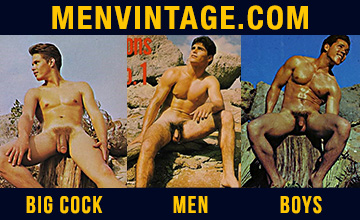Developing the Forearms
By George F. Jowett
The development of the forearms is a problem to thousand of body builders, but the author, who is famed for the size and strength of his powerful arms, offers valuable help in this fine article. He sets you right on many questions, and explains why certain beliefs are mere fallacies. With usual thoroughness, he picks apart the entire muscular scheme of the forearm in such a manner you can visualize the entire-plan unfold before- your eyes. He presents practical facts gleaned from many years of personal experience, and from teachings others. It will help you immensely to build your forearms as you want them.
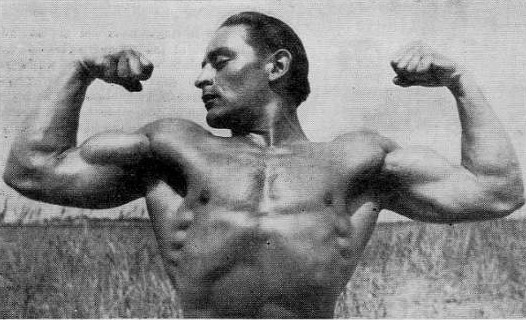
It is commonly said that the calves and the forearms are the two muscular parts of the body that are the most difficult to develop. It is quite true that many do find them very stubborn to respond to an appreciable increase in growth, but the fact remains that the forearms and calves are composed of the same type of muscles as the rest of the body. It is not any particular peculiarity in the muscular construction of these parts that makes development difficult as much as the fact that these two parts are functioning more vigorously daily, which causes a greater density of tissue that makes the necessary breaking down process of the old tissue a more serious task. This must be done first before growth can take place.
Some choose to term this difficulty a natural condition. Possibly it is; nevertheless, It does not alter the natural order of tissue replacement. My experience gained from observation is that most body builders expect the forearms to respond as readily as other parts, and when they do not they become disgusted and say it just cannot be done for one of many reasons — the most common ‘being, that they have small wrists.
In years past, this old alibi has been drummed into the body builder. To my mind, the alibi just a satisfactory excuse for the incompetent instructor and the indifferent body builder. Naturally all are not indifferent. Many try hard, which puts the burden for non-success where it belongs — upon the instructor.
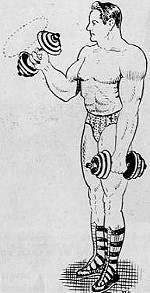
In my study of various body building courses. It is quite noticeable how are deficient in supplying the pupil with the proper explanation, construction and function, treatise and exercise for the forearms.
The small-boned wrist theory always makes me ask the question, “What is a small wrist?” I never get an answer. The defect, if it is one, is more assumed than is actual. During many years as an instructor. I have had the opportunity to observe numerous body builders. Many were famous for their arm strength, and many others with fine arm development could have been equally famous if their inclinations had been toward professional performance or amateur competition. Many of these specimens did not have large bony wrists; very few did. To the average body builder, some of these wrists would have appeared large, and the tape would have justified the fact — but it rarely ever was all bone girth. What was most apparent was the strong mass of muscle and sinew formed around the wrist. As an example, let me quote myself. My wrist measures around 9 ½ inches. Yet, those who can go back far enough to remember me in my earlier days when I was only a middleweight, growing into a heavyweight, will recall that my wrist measurement was given a-round 7 ¼ to 7 ½ inches. As far as years ago, I had then reached manhood’s estate and the age when bones had reached the limit of natural growth in my particular case. Now, is it foolish to assume that the additional two inches gained on my wrist girth could be pure bone? Of course not! My Forearms increased with any other development that transformed me into a heavyweight, and with the increase of forearm size went wrist size. Of course many heavyweights never secured the sized arms and wrists that I and others got, but that was simply because they did not apply themselves as I and others had done.
At the same time, it must always be understood, as explained in previous articles, that a man who is naturally a lightweight cannot expect to obtain the wrist and forearm size of the heavyweight. Yet, there are many cases where men who were to all appearances naturally Inclined to be of an average bodyweight, but who became heavyweights. Like myself, they were not content to belong to the average bodyweight class, no matter how fine their development, nor how great their strength was at the weight, they persevered and so built their body until they finally became heavyweights. Usually, these men can be identified by their bony structure, that is if you observe closely enough. As an example, many remark about my heavy wrist formation, but by squeezing the wrist at the sides, the muscular bulk is forced away and shows clearly the natural bone size, which is not much different than it was when I was a middleweight. In other words, you too, can build your forearms to greater size if you will only be persistent enough. Forget the small-boned wrist idea. Muscle is muscle, and the right type of exercise will break down any stubborn tissue and allow greater growth in replacement.
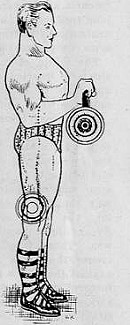
Many instructors lacking sufficient information on forearm development advise that the constant gripping, and lifting of dumbbells of barbells during exercise provides sufficient exercise for the forearms. That is not so, because in those same movements, yon are only using the arms in the manner in which they are most accustomed. The -muscles being fully used to those movements, even though they may be more vigorous movements, will no more respond to growth than will pick and showel work increase the arms of the laborer.
Like developing any other part of the body, you must understand the construction and function of the muscles. The forearm muscles, due to the natural crossing action of the radial and ulna bones of the forearms, are arranged to provide more diversified action.
The forearm muscles are capable of four movements — supination — pronation — flexion and extension. This being the case, the mere gripping and bending the arm, lifting to the shoulder, is only one part of their fourfold action. Exercise must be employed that works the muscles from every line of their natural angle. The swift movement of the arms in weight lifting is too quick to classify the action as muscle building exercise. In a lift, there is only the momentary grip, and pull up, that hurls the weight to the shoulders, then the muscles more or less relax in order for the arms to bend, and get under the weight. The forearms are little used in the overhead heave, except at the conclusion of the lift when the supinator longus of the forearm helps to support the triceps of the upper arm in locking the arm at the elbow. To give muscles benefit, the action must be an exercise movement that thoroughtfy stimulates action throughout all the issues, therefore, the movement must be reasonably slow and complete. Particularly Is this true with muscles that are more than ordinary dense In their tissue structure, otherwise, the breaking down of old issue will not be sufficient.
The forearms are divided into a very complex arrangement of nineteen muscles. These muscles are slender-bellied, and with very long tendons. The muscles proper, on the front of the forearm, extend about three-quarters of the way down to the wrist, the rest of the connection to the hand is tendon. Those on the back of the forearm are longer, but these also have long tendons as an examination of the anatomical illustrations of the forearms accompanying this article show.
The origin of most of these muscles are inserted on the bone of the upperarm to become finally attached onto the wrist and hand.
In the last issue, explaining the biceps of the arm, I showed how the biceps were attached upon the bones of the forearm, and as the forearm muscles originate on the bone of the upper arm, you can better understand now why the arm is so powerful in bending the forearm on the upper arm. Everything muscular Is arranged this way. Those who are seeking to increase the depth of the upper arm against the elbow fold can realize that forearm development is also a necessary part of the plan to create this desirable powerful formation.
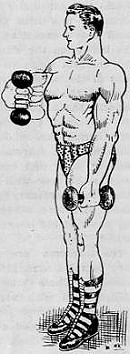
Of the nineteen muscles in the forearm, four are concerned with pronation and supination, nine with the thumb, and six with the wrist, and they all have capable extension and flexion. When you hold the arm with the back of the hand up, that is the prone position, the reverse is the supine. This action aided by the crossing of the bones, permit the hand to rotate on the wrist 180 degrees, or a half circle. The rotation of the hand is caused by the crossing of the forearm bones, and not by the wrist alone. These bones control the wrist movement, therefore, you must always bear in mind that it is the forearm that involves the movements of the wrist and hand. This being a fact, all hand and wrist movements in turn involve the forearm muscles, and the hand and wrist is the angle from which we must begin in order to develop the muscles. The only thing left is to know in which direction the hand and wrist should be bent in order to get at all of the muscles. These movements comprise the exercises necessary for the purpose.
You must always remember that the actual functions of these muscles are short. The length of their pull is controlled by the limation of the hand bending on the wrist. Therefore, the true exercise operation must be gauged from the straight arm position, and bending the hand on the wrist in the varied exercise position. From this line of action, only light weights should be used, otherwise the swing of a heavy weight is going to create a momentum which will deprive the muscles of a steady complete movement.
There are exercises that are very influential for the forearm muscles that require a bent arm. These efforts are more sustained muscular contraction. By that I mean, after the muscle has become contracted from a movement, the bent arm will sustain the final contraction in a greater degree. Then there are movements of this nature which are necessary because of the supinator longus reaching high onto the upper arm bone, co-ordinates with the triceps. We must also bear in mind what I told you in last month’s issue how the biceps have a functioning relationship with the forearm. With these facts in mind you will understand the reason for light weights with certain exercises, and heavier weights in other exercises. The latter are employed where the muscles of the upper arm coordinate with the lower arm. In other words, you must know the how, when and where to employ heavy and light weight.
The forearm muscles having only an actual short range of contraction will permit, in many cases, a very much increased poundage per exercise, and what is also very important, one can exercise the muscles of the lower arm without any danger of organic reaction. The reason for this is because the forearm muscles are not directly associated with the organs. They also act more independently of other groups which enable their physical capabilities to be more safely and definitely controlled.
The thumb is an important consideration, too, in forearm development. While nine forearm muscles are concerned with thumb action, there are three that are directly associated with it—a short, and a long extensor, and the long abductor. The thumb, like the little finger has more freedom than the other fingers. While the little finger is much weaker than the thumb yet It has three direct muscles connections,—abductor, flexor and opponens.
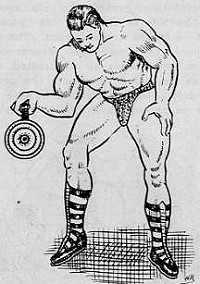
The little finger does not act as independent of the other fingers as does the thumb, which means, while you can grip collectively with all fingers the thumb is not necessarily acting, so you should remember to grip strongly with the thumb when holding a weight in the hand during exercise.
The common extensor of the forearm branches into four sections, to be attached onto each finger. The palmaris longus extends from the bone of the upper arm down the forearm ending into a broad sheet of tissue that forms the palm of the hand. Other hand muscles of fleshy bulk form on the top of the fascia. On the back of the hand there are no fleshy, muscles, just a series of tendons. Of course there is a series of superficial muscles forming under the forearm surface muscles which you are more familiar with. These are equally stimulated by the exercises given
The one muscle one should be careful with, particularly weight lifters, is the supinator longus, that runs high on the upper arm bone and supports the triceps. Many lifters strain this muscle, which pains slightly and makes the arm weak in certain arm movements. This is because this particular muscle is not carefully developed strongly enough to co-operate with the effort the triceps demand. There is a little triangle shaped muscle at the upper part of the forearm named the Anconeus that also supports the triceps. This muscle is considered an elongation of the triceps by anatomists, and is developed in unison with the supinator longus.
If you are keen to develop the forearm muscles, it will pay you to read over the explanation given herein several times, so everything is properly grasped in your mind. After all, the forearm is a complex arrangement of muscles, and while I have tried to be brief, and yet cover all the important features necessary to know, study will clarify the subject .more to you. I have not covered all of the muscles separately, simply because so many of them operate will each other in groups that deal with the four explained movements of the forearm muscles.
The exercises submitted for your benefit within this article should be practiced as shown and described. Where a dumbell is advocated, use it. Where a kettle bell is advised use it, also where a solid dumbbell is advised gripped in the hand by the end, use it that way. In this last named, where one holds the dumbbell toy the end and describes a circle with the other end, moving the hand on the wrist, you will probably recognize an old exercise. I have noticed of the late that many have deviated from this exercise principle, using a dumbbell gripped by the bar. This is wrong in two ways. It induces one to use too much weight. The detriment of this is that once the exercise motion is set up a momentum is gathered by the heavy bell. This causes the bell to swing as the hand rotates and deprives the muscles involved of the progressive resistance necessary for development. Moreover, by holding the bell by the end, you obtain full grip of the thumb and little finger, as well as the other fingers If you grip a bell by the bar you are deprived of thumb, and little ‘finger benefit. The thumb is most important. Holding the bell by its end compels you to perform the exercise correctly, and docs the work it is ordained for.
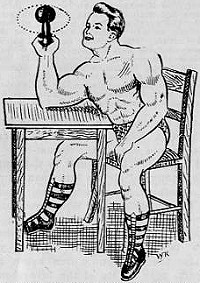
There is not so much difference in muscular construction in the forearm as often met with in other muscles, as explained in other ‘previous articles. The forearm size is less deceiving than other muscular bulk. There is less chance for coarse tissue because the forearms are actively employed daily. You can readily tell the difference between a true strong forearm, and a weak one. The muscles stand out in stronger relief, or else the fore-arm is fat. There is the only real difference. After- this, the forearm size and muscular display becomes a true index of power.
Most forearms show the greatest development on the outside the Inside particularly when the muscles are flexed with the hand and forearm In the goose neck formation, is usually sadly lacking. When the front of the forearm is fully developed and when flexed will take on a canoe-like shape from wrist to elbow.
The front of the forearm takes on a different shape with different muscular types. Some display an abrupt bulk just bellow the elbow when the arm is posed in the goose neck position, and the rest of the arm to the wrist is slender. When this occurs, the forearm at its buging point looks larger than It really is. This happens when the frontal muscles are not fully developed over their entire length. As these muscles develop over their length, the sinew insertion into the muscles becomes thicker with the muscle, and this cordiness is what makes up the heavier wrist and stronger arm. I have seen many arms praised (because of this short abrupt bulking, but my experience has proved to me convincingly that they are not the strong type arm of outstanding physical merit. Men who are famous for their arm strength showed a forearm that bulked with thick sinew from the wrist to the elbow. The back of the forearm was broad with a muscular sweep rolling over the elbow and down. The ball of the thumb was thick muscle as also was the outside wall of the palm of the hand. Men like Karl Moerki and Thomas Inch are outstanding examples of men naturally endowed with small wrist bones. Their normal wrist did not exceed much over six inches in circumference, and the bony structure of the hand was small, but look what arms they built. You could see the powerful muscle banking on the front, and along the outside wall of the wrist, and they were both extremely powerfully armed.
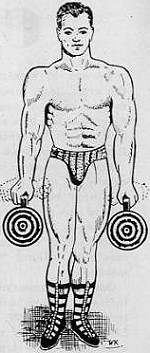
Exercise will build for anyone splendid, powerfully formed forearms who strives hard and long enough, but one should also combine other variations of practices as an interesting deviation from exercise. Rope climbing is great, especially when one gets to the point where the rope can be climbed with hands alone. Chinning the bar to the half- up position, with the hands gripping in varied positions, such as the regular grip with palms of the hands facing front, then in the reverse position, then with hands using the alternate grip. Hand balancers always display powerful, well-formed forearms. The constant pushing up of their body-weight balanced on the hands employs every muscle in the forearm. Bending, and twisting iron bars into varied forms, and the bending and breaking of spikes is also a fine developer. The sport of wrist turning provides another fascinating form of forearm exercise. It is the particular sport of the strong armed fellow, and many wonderful tourneys of arm strength have I seen pitted together in a wrist turning contest.
In former Germany and Austria, there were hundreds of clubs that had teams devoted entirely to the sport of kettle bell juggling. What a he-man’s sport that is! The varied spins, twists and turns, the constant catching and swinging, saying nothing about the footwork, timing and keen eye required. It gets at every muscle as no other sport can. It is an arm developing sport de-luxe. On the other hand we read of feats claimed as being great feats of arm strength that actually are not. As an example, I can recall quite a number of years ago visiting a friend in an other city who simply worshipped a local Herculean athlete. He told me that this man would show me what real arm strength was. I was only a middleweight then, but was considered fairly strong-armed. This particular athlete had such a grip that he could raise off the table top a large iron ball which it was claimed no other athlete had ever been able to budge. While I have a large hand, the other fellow bad a larger hand. On sight, lie said I could not move the ball because my hands were not large enough. Nevertheless, he began to demonstrate and to the consternation of my friend he failed on every attempt. I then asked if I might try. My friend was indignant. What was the use of me trying when this giant had failed! He weighed about 265 lbs., nevertheless, at the first attempt I raised the ball, and held it, much to their consternation. This stunt was thought as being a great feat of arm strength. It was not as much a feat of arm strength as it was a feat of having so much strength and knowing how much to employ on the grip over a certain degree, simply squeezed the ball out of the hand. What the Hercules had not noted was that ‘I had an enormous thumb joint. In fact the thumb joint of my hand constitutes more than one-third of my hand spread and size. The thumb ‘being so large and strong, a-long with the little finger grip, did the trick. I merely employed enough force to enable the ball to cling to the hand and gently raised it off the table in a perpendicular line. A clever stunt all right, but did not require as much arm power as other feats I knew of, and which I had seen performed. This bears out what I say that many feats that imply great strength to perform are not always so, therefore, do not be misled, stick to the practices that are proven of the right order. Practice the exercises without deviation as instructed. Any deviation might only be some other fellow’s pet idea, or because he has some physical peculiarity that enables him to do a particular stunt difficult to others without the same peculiarity.
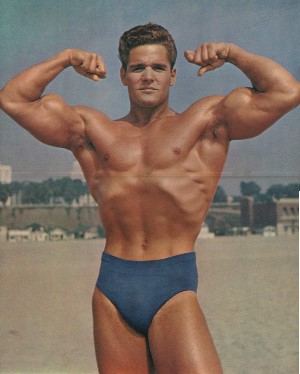
Personally, I regret that lifting clubs and body builders in this country do not follow the practice of juggling kettle bells. I will never forget my initiation into the sport. As a work-out, we stood in a wide circle and tossed the bell to each other. After only a very short time, and I mean short, my forearm muscles began to ache like no one’s business, but I stuck, vanity got the best of me, and for the next couple of days a my arms were like sticks. Later, I practiced the game with more common s sense, and attribute much of the gain gotten in forearm development along with the special exercises, to this sport.
There are numerous other exercises t that can be practiced which lack of s space prevents me from giving more t than I have herein, but these will suffice, and another article I will cover e more of them. While these exercises do give a wonderful benefit to the wrist, yet, there are other exercises that involve wrist movement exclusively. This is done by nutralizing as much forearm action as possible, making the wrist do the major work, which is the opposite in forearm exercise. The wrists will be treated in a s special separate article. I aim to make this series the greatest treatise of it physical development, far beyond the range of what a book could contain, only at a greater cost than one could pay. Follow them through and enjoy the practical benefits that experienced instructions yields to you. These forearm exercises will help you more than you may now realize. Start off with weights well within your control, and increase one repetition every third practice night until you have reached the limit of repetitions to comfortably perform. Never fatigue your muscles, instead, add a little more weight and start over with the original low count and work up as before, and the results will be, the development of a fine powerful forearm which will make you feel proud to roll up your sleeve and show to anyone.

